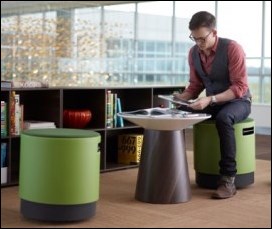by Brianna Crandall — June 26, 2013—Global workplace products, furnishings and services provider Steelcase launched its ground-breaking Gesture office chair at NeoCon 2013 in Chicago June 10-12, bringing home a Gold Award in the Seating: Ergonomic Desk/Task category of the Best of NeoCon Competition. Among Steelcase’s other seating introductions at NeoCon, Regard by Nurture also won Gold in the Healthcare: Guest/Lounge Seating category; Lagunitas by Coalesse won Gold in Seating: Benches; and Buoy (described below) won an Innovation Award in Seating: Guest.
Steelcase bills Gesture as “a new sitting experience:” the first chair designed to support users’ interactions with today’s technologies. The chair was inspired by the movement of the human body and created for the way we work today, with today’s most prevalent devices such as smart phones and tablets.
Gesture was designed in response to the company’s latest research about changing postures in the workplace. The global study, conducted in 11 countries and observing over 2000 people in a wide range of environments, reveals how new technologies have led to nine new postures — such as “The Swipe,” “The Trance,” and “The Strunch,”—that Steelcase says are not supported by current office chairs and that frequently cause pain and injuries, disrupting concentration and creativity.

“Tablets were introduced just three years ago. But many people are using chairs that were designed well before these new devices became pervasive at work,” notes James Ludwig, vice president of global design for Steelcase. “Back then, chairs were created to help people hold one pose in front of a computer all day. Now we know that people need to move and change positions regularly, especially as they engage with new technologies. We observed people in pain—they need a sitting experience designed for the ways we work today,” continued Ludwig.
Steelcase researchers studied how the physiology of work has changed, how the human body interacts with new technologies and how it transitions as people shift from one device to another. Researchers noted a more extreme range of human sizes around the world, which impacts postures. The company also studied the changing sociology of work and how people rapidly shift between individual, focused tasks and creative collaboration. Each new activity caused people to change postures. Based on this research, Steelcase designed the Gesture chair’s three key interfaces — the core interface, upper limb interface and seat interface — to support new postures driven by new technology and more casual behaviors in the workplace.
For example, Gesture encourages motion rather than forcing the body to hold a single posture. The upper limb interface allows people to draw closer to a work surface to avoid hunching over a screen and easily move close to the body to support texting postures. Unlike conventional chairs, the Gesture chair’s core interface hugs the lower back when people recline to scroll on a tablet screen, explains Steelcase.
The seat interface adjusts rapidly to help users avoid perching on the edge of their chair, says the company. Gesture embraces a broad range of body sizes and easily adapts to meet the needs of each individual user, which is critical in an increasingly global business environment that has to support a more diverse workforce than ever before. The Gesture chair is a system of interconnected parts — inspired by the human body — designed to support every movement.

Also based on research and intended to encourage natural active sitting, the Innovation Award-winning Buoy stool wobbles and spins and encourages movement thanks to a curved base, like an ocean buoy. After researching multiple small businesses, Turnstone noticed that people are mobile, even when seated, whether it means bouncing their knees, tapping their pencils, or leaning back in their chairs.
Buoy’s innovative, customizable design encourages this natural mobility and self-expression among the new generation of workers and boosts performance in anyone by keeping the body in motion and the mind active. It bucks the trend of sedentary lifestyles and work styles by swiveling, turning, tilting and moving up and down. The 20-pound stool offers a height-adjustable base with a built-in handle for moving, and is designed for easy cleaning and maintenance.
The base comes in six bold colors, and the cap can be personalized with over 25 fabrics, including designer fabrics such as Maharam and British designer Paul Smith’s Exaggerated Plaid. The cap can be swapped out at will to keep the look fresh or match a new decor.




